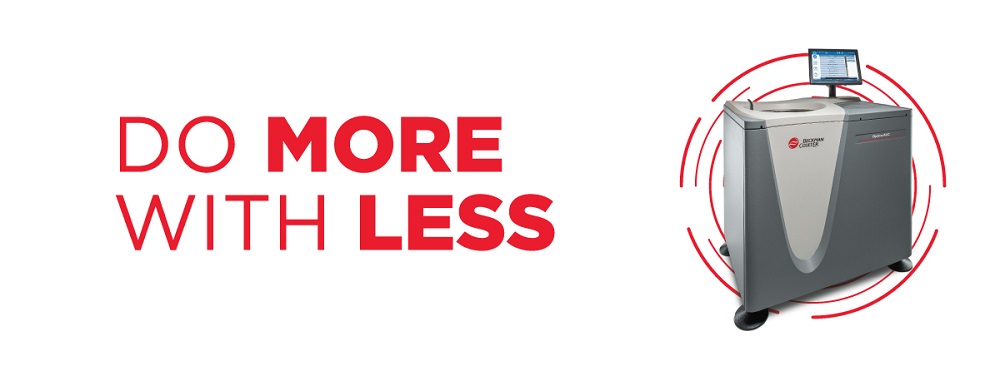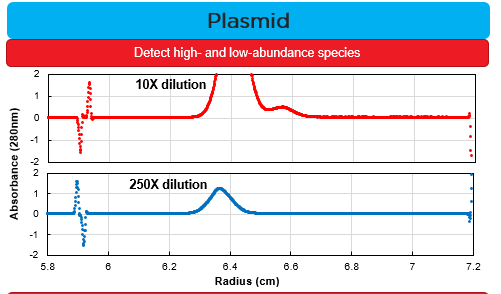
Run more with less: DGE-AUC gives higher throughput with lower sample requirements
Density Gradient Equilibrium AUC (DGE-AUC) helps your lab do more with less.
DGE-AUC is amenable to samples across a range of concentrations and removal of common stabilizers like pluronic or sucrose is usually not required. This allows for direct analysis with minimal manipulation of most samples including in-process and formulated samples.
DGE-AUC offers faster time to results with higher throughput
With DGE-AUC, you can run more samples in a day and get answers faster when you use a six-sector centerpiece.
This gives you the flexibility to:
- Run 21 samples in a single rotor, in a single run
- Expedite turnaround time with shorter path lengths (~1 hour for adenovirus is possible)

The quicker turnaround times expedite the development process and allow you to make informed decisions on in-process samples before moving forward.
Throughput, sensitivity, and resolution are highly tunable in DGE. Parameters like sample volume, speed (RPM/rcf), starting solution density, temperature and more can be adjusted depending on your needs.
DGE-AUC high sensitivity for lower sample requirements
Like density gradient ultracentrifugation (DGUC), DGE-AUC uses the gradient to concentrate particles into discrete bands, providing tremendous sensitivity. This method may be able to achieve up to 30X greater sensitivity than Sedimentation Velocity AUC (SV-AUC).
Below is an example scenario to demonstrate band compression in DGE-AUC:

In the example image, the sample starts out with a homogeneous radial distribution (light pink), spread from 6.0 to 7.0 cm with an absorbance signal of 0.0625 absorbance units (AU). Over time, as the density gradient forms, the sample becomes increasingly concentrated at a fixed position (red), resulting in a significant increase in signal at equilibrium – this is a notable advantage over SV-AUC which allows less sample to be used.
DGE-AUC also provides you with flexibility to experiment with the amount of sample you use. A practical example of the radial concentration effect for a plasmid sample is shown below. With a 250x dilution of the stock sample (blue), there is a single, well-resolved peak present.
At a higher concentration (10x dilution), the main peak is significantly overloaded. However, it is only overloaded at that position and we actually see another peak emerge that was not visible in the 250x dilution. This allows for detection of low abundance species which would otherwise be difficult to detect with SV-AUC.

DGE-AUC gives you superior flexibility - not only does it offer a wide range of accessible concentrations/absorbances, but you can also manipulate the loading concentration based on your needs.
Balance between resolution and sensitivity
With DGE-AUC, parameters like speed can be easily adjusted to optimize the balance of resolution and sensitivity – speed directly affects the profile of the density gradient that forms. In general, high speeds offer improved sensitivity and lower speeds offer improved resolution.

The slope of a gradient is altered by speed and results in a balance between sensitivity and resolution.
- High speed generates a steep gradient, providing the greatest sensitivity as the sample becomes more concentrated into a smaller radial range. This allows a wider range of particle densities to be observed at once.
- Low speed generates a shallower gradient, pushing bands further apart and for increased resolution.
Because DGE-AUC is an endpoint analysis (i.e., not time-resolved), scan averaging at equilibrium can significantly improve the signal-to-noise ratio. In addition, unlike SV-AUC, there’s no trade-off between monitoring multiple wavelengths and resolution, and you can easily analyze 90 wavelengths.
Get started running DGE-AUC Experiments with the Optima AUC
Ready to start spinning up DGE experiments for robust and simple data analysis? We can help!
Get in touch today to find the best solutions for your lab!
*Third-party analysis software, including Excel and Origin, has not been validated by Beckman for use with the Analytical Ultracentrifuge. Beckman does not endorse any third-party analyses software. Beckman warranty and/or performance guarantee that may be applicable or are provided by Beckman for Analytical Ultracentrifuge do not apply to any third-party software.

